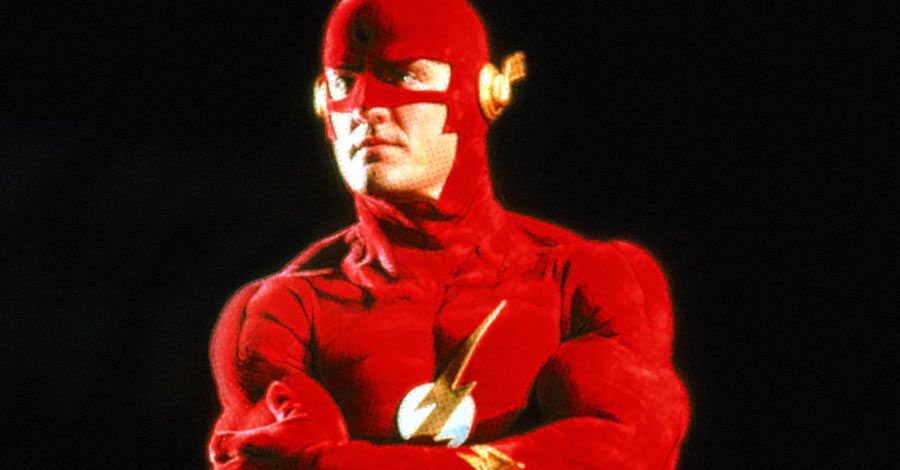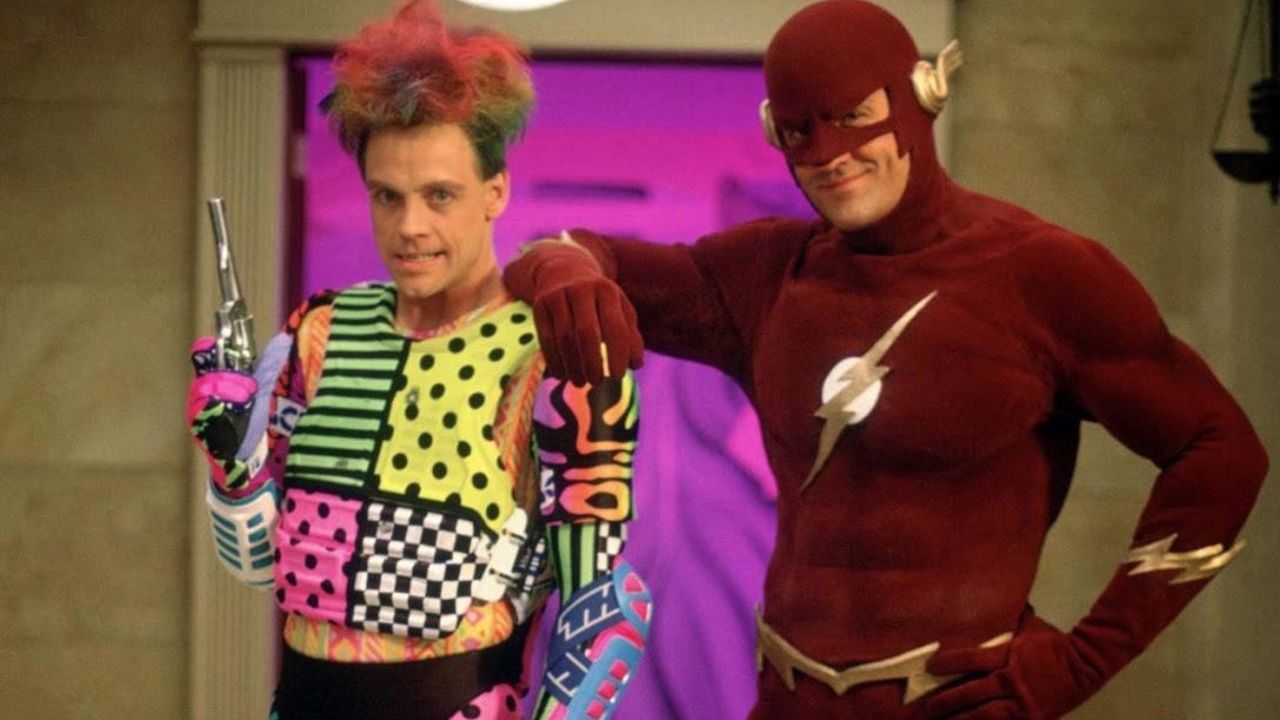Los Angeles became Barry Allen's new home this past Saturday for a special, one-night-only event celebrating"The Flash" -- not the current CW hit, but the CBS iteration of yore starring John Wesley Shipp as the scarlet speedster.Hosted by The Cinefamily at the Silent Movie Theatre in LA,which is known for its special events and retrospective programming, the non-profit organizationfrequently shines a light on entertainment worth a second look. CBS' "The Flash" certainly fits that bill --when it originally aired in 1990, it was during a time when superhero fare was sparse, and far from the mainstream pop culture fixture it has since become.
The night began with screenings of two episodes from the vintage show("The Trickster" and "Trial of the Trickster"), followed by a Q&A moderated by Badass Digest's Devin Faraci. What began as a tribute soon became a reunion, as numerous members of the series' cast and crew lined the front of the packed theater. Creators/producersDanny Bilson and Paul De Meo and starJohn Wesley Shipp found themselves joined by co-stars Mark Hamill (The Trickster), Joyce Hyser (Megan Lockhart), Corinne Bohrer (Prank),Mike Genovese (Lt. Warren Garfield),Marsha Clark (Denise Cowan),and Vito D'Ambrosio (Officer Tony Bellows), suit designer Robert Short,director Bruce Bilson, co-producer Michael Lacoe, 1st AD/writer David Newman,writers Howard Chaykin and Gail Morgan Hickman -- plus executive producer ofthe current "Flash" series and "Arrow," Andrew Kreisberg.
RELATED: EXCLUSIVE - Grodd Strikes in New "The Flash" Photos
Coming off the heels of Tim Burton's "Batman," "The Flash" wasoriginally intended to be part of an ensemble superhero show titled"Unlimited Powers," which never got off the ground. "A year later, somehow we managed to convince [CBS] to do 'The Flash,'" Danny Bilson said. "I don't know how we convinced them to do 'The Flash,' because thebig story is the guy running CBS at the time wanted a track suit with LEDs and tennis shoes."
Thankfully, with the help of revered late comic artist Dave Stevens (Bilson and De Meo were collaborating with Stevens at the time on "The Rocketeer" film), they were able to flesh out a practical,liveaction Flash outfit without blinking lights. "Dave designed that version of the Flash suit. He drew it, and we took it to CBS and showed it to [former CBS President] Jeff Sagansky, and that's how we got the costume approved," Bilson recalled."Really, with the costume came the whole ball of wax -- all the tone, allthe heart, and everything else."
It was then up to costume designer Robert Short to figure out the logistics of how to bring the costume to life. "I had a meeting with Paul [De Meo] and Danny [Bilson] and they said,'We want the Flash suit to look just like the comic... it can't have any seams,'" Short said.From that point, Robert Short went off and created the burgundy-red, textured suit seen in the show. The suit,Short says,was "a whole experimental thing that had never been done before, by overlapping foam appliances, and then covering them with electrostatic flocking, which meant that we had to put an electrostatic charge through the suit -- not while anyone was wearing it."
For most of the series, John Wesley Shipp's Barry Allen was the only character wearing a costume -- until the introduction of Mark Hamill as The Trickster. Clad in bright, skintight spandex, a thin, blue cape and multicolored hair that stood straight up, Trickster was the first villain on the show to display a touch of flair that echoed his DC Comics inspiration. Hamill's performance not only brought the insanity of the character to life, it did so with charisma and an understanding of the source material."One of the most difficult things is translating these things that work on the page of the comic books, and doing it on camera without making it look totally ridiculous," Hamill explained.
The actor not only proved just howfamiliar he is with the comic, detailing theoriginof The Trickster -- a villain who developed shoes allowing him to run into the air in order to hijack planes -- but also explained his reasoning as to why he got the job. "I know why they cast me: Because he's literally a 'sky walker.'"
The two Trickster episodes set the standard for what superhero shows could be, in large part due to comics veteran Howard Chaykin, who not only wrote the episodes, butwas brought onto the show tolend his expertise as a comic book writer. "It was an opportunity to delve back into my own boyhood... ['The Trickster'] is much lighter and goofier than other episodes in the series," Chaykin said, discussing the show's Silver Age influences. "This was my first job in television... It was the best professional experience I've ever had in my life. I metpeople that I will gladly go to their memorial in good faith."
Unfortunately, the show was short-lived, leaving manyadventures the creators wanted to do on the drawing board.Now,25 years later, Kreisbergand company have continued the character's TV legacy with the current series, aworthy heir to Bilson and De Meo's show. Asked how much the 1990 version influenced the current series, Kreisberg said,"Geoff [Johns], Greg [Berlanti] and I were just huge fans of the show... We get a lot of credit for doing this giant movie every week, but you see what went into making ['Trickster' and 'The Trial of The Trickster'], and it wasn't digital. You guys blew all that stuff up. It meant the world to us. If you watch our iteration, you see so many nods to it."
"[Danny Bilson and Paul De Meo] had this great take on [the suit], which was that it was a deep sea submersible suit and it was made by the Soviets, which is why it was red," Kreisberg said. "When we sat down, it was one of the first things thatI said was that I always loved the fact that [Barry Allen] didn't just decide to dress up like a superhero. It was something that they had in S.T.A.R. Labsthat he repurposed. So, in ours it was a turnout for firemen... whichis why it was friction-proof."
The presentation closed by turning back to show creators Danny Bilson and Paul De Meo to find out what fans wouldhave seen on a second season of the show,and the big plans they had going forward especially in light of the uplifting note of its season/series finale. "We now had a license to do what they're doing now," Bilson said, giving a nod back to Kreisberg's show. "We wanted to do more Mark [Hamill]. We wanted to do more Mirror Master. We wanted to unchain Howard [Chaykin] even further, and have more fun."


